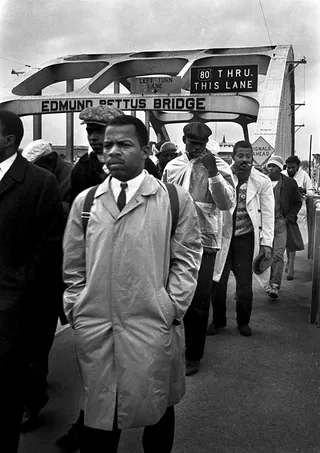Are Your Voting Rights in Peril?
Supreme Court to consider key Voting Rights Act provision.

1 / 14
On the Docket - On Feb. 28, the U.S. Supreme Court will hear Shelby County v. Holder, which challenges the constitutionality of Section 5 of the Voting Rights Act. Section 5 requires some states and parts of others to seek Justice Department approval before making any changes to voting laws and maps. Opponents of Section 5 say that times have changed and the law should, too. They point to President Obama's two terms in the White House as an example of how the nation has evolved. — Joyce Jones (Photo: Official Government Photo)

2 / 14
What's at Stake - "Section 5 prevents discrimination before it happens. Without it, we'd be filing lawsuits after a law is put in place and discrimination has already happened," said Judith Browne Dianis, co-director of Advancement Project. "With voting, you don't want to wait until after the discrimination occurs because that means your right to vote has been impacted." (Photo: Earl Gibson III/Getty Images)

3 / 14
In the Beginning - Although the 15th Amendment prohibited preventing people to vote based on race or color, several mostly Southern states continued to deny Blacks the right to vote. They applied a variety of methods, including literacy tests and poll taxes. (Photo: Courtesy of Libary of Congress)

4 / 14
In Name Only - Enacted on May 6, 1960, the Civil Rights Act enabled the Justice Department to inspect all records related to voter registration and introduced penalties for obstructing anyone's ability to register to vote and cast a ballot. The bill, signed by President Dwight Eisenhower, proved to be ineffective. (Photo: Keystone/Getty Images)

5 / 14
The Freedom Summer - Organized by a coalition of civil rights organizations, thousands of activists and volunteers, including many white college students from the North, "invaded" Mississippi from June to August in 1964 to register as many Black voters as possible. They also registered voters in other Southern states. (Photo: PhotoQuest/Getty Images)
ADVERTISEMENT

6 / 14
Bloody Sunday - On March 7, 1965, 600 civil rights demonstrators set out to march across the Edmund Pettus Bridge from Selma to Montgomery, Alabama, to protest efforts to deny Blacks their right to vote. The march was aborted when participants were brutally attacked by state and local policemen, forcing them to retreat. (Photo: Birmingham News /Landov)
Photo By Birmingham News /Landov

7 / 14
Turning Point - After viewing the violence of Bloody Sunday on television, President Lyndon B. Johnson introduced a bill to Congress that would eventually become the Voting Rights Act of 1965. "At times history and fate meet at a single time in a single place to shape a turning point in man's unending search for freedom," Johnson said of Bloody Sunday. (Photo: Courtesy of Library of Congress)

8 / 14
Check and Balance - On Aug. 6, 1965, the Voting Rights Act of 1965 became law, prohibiting anyone from being denied the right to vote based on race. In addition to Section 5, which required certain states to pre-clear any changes to its voting laws and maps, it also outlawed literacy tests. (Photo: Eric Thayer/Getty Images)

9 / 14
More Work to Do - In 1970, Congress extended Section 5 of the Voting Rights Act for five years and again in 1975 for seven more years. In 1982, lawmakers extended Section 5 for 25 years. (Photo: AP Photo/Kathy Kmonicek)

10 / 14
The More Things Change - During the recent presidential election cycle, several states attempted to change voting laws in ways opponents said would make it more difficult for minorities, low-income people, seniors and students to vote. (Photo: Sara D. Davis/Getty Images)
ADVERTISEMENT

11 / 14
Section 5 at Work - In 2012, Section 5 prevented Texas from implementing a photo ID requirement deemed discriminatory against Blacks and Latinos. It also stopped Florida from reducing the number of early voting days. (Photo: Mark Wilson/Getty Images)

12 / 14
Obama Weighs In - In a radio interview, Obama said that minorities will still have the right to vote and to not face discrimination, but "won't have this mechanism, this tool, that allows you to kind of stay ahead of certain practices." (Photo: Mark Wilson/Getty Images)

13 / 14
The Cup Half Full - If the Supreme Court upholds Section 5, which the Advancement Project's Dianis predicts it will, she believes states will be deterred from trying to pass laws or implement practices that harm the voting rights of people of color. "This last election cycle showed that we need more voter protections, not less," Dianis said. The Supreme Court has upheld Section 5 four times. (Photo: Jamie Rose/Getty Images)
